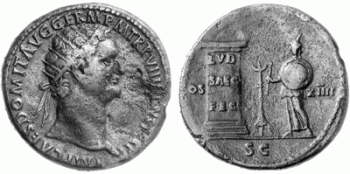American Journal of Archaeology | The Journal of the Archaeological Institute of America
You are here
Visualizing Ceremony: The Design and Audience of the Ludi Saeculares Coinage of Domitian
October 2006 (110.4)
Visualizing Ceremony: The Design and Audience of the Ludi Saeculares Coinage of Domitian
Domitian’s Ludi Saeculares coinage (88 C.E.) violates the usual patterns of Roman mint production: one festival dominates all six denominations of gold, silver, and bronze. Consistency in legends and in reverse types across the issue suggests that unusual care was taken in designing these coins. One composition is even repeated in both silver and bronze. Ten events during the Ludi Saeculares, nine of them religious rituals prescribed by the Sibylline oracle, are depicted on the bronze coinage. Variations among specimens within each type, however, indicate that some details, such as the pedimental iconography of temples, were created by individual die carvers and must not have been specified in the original design. Using the textual evidence for other imperial celebrations of the Ludi Saeculares, previous scholars have focused on matching each coin type with a known event and each architectural background with a specific location in Rome. This article reveals the problems with such an approach and uses instead a variety of historical, iconographic, and numismatic methodologies to explore questions of design, audience, context, and interpretation. I conclude that, for a limited audience, these coins attempted to send a coherent message emphasizing the solemnity and ritual completeness of Domitian’s Ludi Saeculares and linking his celebration to Augustus’ Ludi Saeculares of 17 B.C.E. But, because Domitian’s experiment in using the coinage for detailed communication was not subsequently imitated, this set of coins is unique.
Visualizing Ceremony: The Design and Audience of the Ludi Saeculares Coinage of Domitian
By Melanie Grunow Sobocinski
American Journal of Archaeology Vol. 110, No. 4 (October 2006), pp. 581–602
DOI: 10.3764/aja.110.4.581
© 2006 Archaeological Institute of America


